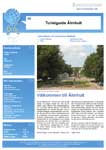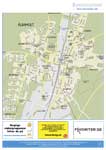Welcome to Älmhult
It is easy to live In Älmhult, because almost everything is close and easy to reach - just a few minutes to work, day nurseries, shops, cafés, leisure facilities, or out on the lake to enjoy the nature. Älmhult is located close to Lake Möckeln, and has many outdoor activities such as, canoeing and fishing. Camping, cycle trails and excellent walking paths are also within the proximity of the lake. Älmhult is situated in the south of Småland and in the county called Kronobergs Län. Älmhults Municipality consists of 889 square kilometers of mostly forests and lakes. Of its 15,500 inhabitants, approximately 5,000 live on farms or in outlying villages, with the remainder located in the city.
Älmhult is famous for the world’s first IKEA store and founder, Ingvar Kamprad. In addition, the world famous Swedish scientist, Carl von Linne, was born in 1707 in nearby Råshult. Älmhult is near to Växjö, which has it’s own airport and to Kristianstad. The coastal areas of Blekinge, Skåne and Halland are also a short distance from Älmhult. Älmhult boasts its own well-stocked library, 18 hole golf course and a wide range of sporting associations and clubs for all age groups. Welcome!
Municipality Facts
Population
15 400
Area
983,28 km²
Regional Center
Älmhult
County
Kronoberg
More Information
Internet
www.almhult.se www.linnesrashult.se
Newspapers
The Smålands Post www.smalandsposten.se Smålänningen www.smalanningen.se
Tourist Bureaus
Älmhult Tourist Bureau Open: Low Season: Mon. -Fri., 0900-1300 High Season: Mon.-Fr., 1000-1800 Sat & Sun, 1000-1500 Stortorget 1, Älmhult www.almhult.se
Notes
Police
114 14
Country Code
+46
Area Code
0476
City
About
Welcome to Älmhult
It is easy to live In Älmhult, because almost everything is close and easy to reach - just a few minutes to work, day nurseries, shops, cafés, leisure facilities, or out on the lake to enjoy the nature. Älmhult is located close to Lake Möckeln, and has many outdoor activities such as, canoeing and fishing. Camping, cycle trails and excellent walking paths are also within the proximity of the lake. Älmhult is situated in the south of Småland and in the county called Kronobergs Län. Älmhults Municipality consists of 889 square kilometers of mostly forests and lakes. Of its 15,500 inhabitants, approximately 5,000 live on farms or in outlying villages, with the remainder located in the city. Älmhult is famous for the world's first IKEA store and founder, Ingvar Kamprad. In addition, the world famous Swedish scientist, Carl von Linne, was born in 1707 in nearby Råshult. Älmhult is near to Växjö, which has it's own airport and to Kristianstad. The coastal areas of Blekinge, Skåne and Halland are also a short distance from Älmhult. Älmhult boasts its own well-stocked library, 18 hole golf course and a wide range of sporting associations and clubs for all age groups. Welcome!
History
Älmhults History
In the middle of the 1800s, Älmhult consisted of countryside with a few large farms, and only a few stores and cottages. Roads were built to transport iron ore, and Älmhult began to grow. In 1901, the King granted Älmhult Municipality Rights. Growth continued and seven regions were added to Älmhults Municipality in 1971. To survive in the wilderness was not easy, most had to learn special skills and crafts, especially in farming and agriculture - along with extremely hard work. This survival instinct which developed over hundreds of years is called "Smålandsandran"; ingenuity, entrepreneurship, thriftiness, diligence, and persistence. It's the reason for the today's wide and successful economic life in both Älmhult, as well as Småland. Three years, from three different centuries are especially interesting and important for Älmhult. -1707, Carl von Linné was born in Råshult Södregård Stenbrohults. Linné was, and is still, one of Swedens most famous scientist. He specialized as a botanist and in medicine but at the same time, was also a versatile entrepreneur. -1862, came the roads to transport the iron ore and then a railway track was built between Mälmö and Stockholm. Älmhult became the central point for transportation and it was actually the year Älmhult was born. In 1874, the railway station was built and was recognized as the most important central point for the area. -1953 Ingvar Kamprad started up a new company called IKEA and his first store opened in 1958. Afterwards, store after store was built over the entire world. Today, IKEA in Älmhult is the World Headquarters for furniture design and also the largest employer in the south of Sweden.
See and Do
Swimming
Bokhultet, Diö
Along Lake Möckeln. Bathing docks, restrooms, showers, grill area, canoe area, and volley ball course. 12 km from Älmhult.
Bökhult, Älmhult
Along the southern end of Lake Möckeln. next to Sjöstugans Camping. Showers, restrooms, bathing docks, playground, food, volley ball court. 1 km from Älmhult. Älmhult towards Pjätteryd.
Bölsnäs, Liatorp
Along the northern end of Lake Möckeln. Bathing docks and restrooms. 18 km from Älmhult Älmhult, north of Linnéleden
Delary
Along the Helge River. Bathing docks, restrooms, fireplace and place for canoes. 10 km from Älmhult. Älmhult, Rt 120 towards Traryd
Kruseböke
Along Lake Krusasjön. Bathing docks, restrooms and grill area. 10 km from Älmhult.
Möckeln
Bathing docks, playgrounds, showers and restroom. 3 km from Älmhult. Älmhult North, Linnéleden
Ramnäs, Göteryd
Along Lake Römningen. Bathing docks and restroom. 18 km from Älmhult. Älmhult, Rt 120 towards Traryd
Sandören, Häradsbäck
Along Lake Sandören in Häradsbäck. Restrooms.
Simhall, Haganäsbadet
25 meters indoor basin. Östra Esplanaden, Älmhult +46 476-552 50 www.haganasbadet.se
Vägla, Hallaryd
Along Lake Vitasjön. Bathing docks, restrooms and grill area. 25 km from Älmhult. Älmhult, Rt 120 after Delary turn left towards Hallaryd
Välje, Virestad
Along Lake Virestadsjön. Bathing docks, restrooms, dressing room, telephone, grill area and camping (fee based). 20 km from Älmhult Älmhult North, Rt 23 www.virestad.nu
Fishing
Fisking Adventure
Älmhults Municipality has many places to create the unforgettable fishing adventure. We have many lakes in the area. Everything from brooks and streams, rivers and fine lakes, both big and small. Apart from fishing, enjoy the wonderful environment and the wildlife in the area. You many even get a chance to see a moose, deer, or one of the other many wildlife in the area. You can find fishing tips and fishing license information on Älmhults website. www.almhult.se
Museum
Mill Museum in Delary
In beginning on the 18th century Göteryd's industrial activity began. The Göteryds Local History Association has created an exhibition showing the industrial development from the beginning of the 18th Century, up until 1981, when the Southern Paper Mill was shutdown. In Delary, there is also a large boiler from the 1870s and a 100 year old locomotive that was constructed and built in the workshops. Near the old Masugnsbacken, in Delary is Göteryd's Bank. The banks history is described in the museum, along with the original furniture and equipment. It started in 1883 on the Delary factory premises and was later moved in 1910, to where it is today. In connection, there has also been a great deal of growth which started in the beginning of the 1900s. From Älmhult Rt 120 towards Traryd, 10 km, on the left side before the Helge River
School Museum at the Culture House - Blohmé
For entrance into the museum, the key is located at the library. Museum Contents: Classroom with different school benches, exhibition display case and cabinet. What to See: School-history over closed schools, all parishes' school history on posters, unique school photo archive with around 650 photos. Many student registers are in the archive as well. School graduation caps, valuable school wall charts from the end of the 1870s in Regnhults School, Stenbrohults school parish. School for the deaf in Bölsö-Rephult, Liatorp, 1870 (1876) - 1894.
Nature
Höö Nature Reserve
From Diö, the road goes through a varying landscape of spruce and deciduous forest along with open meadows and pastures. Gradually, the field of vision extends towards Möckeln to Höö, and continues uphill the next 30 m. On top of the hill, lies an old farm surrounded by large elm and ash trees. People have protected and preserved the area for over many generations. Höö and several smaller islands became reservations in 1969. The area is approximately 110 ha. It has also been documented through scientific surveys and a maintenance plan established. The eastern part of Höö consists of green stone (hyperit-diabas, black granite). Högplatåns west and eastern slopes are extremely steep, so farther to the west the green stone decreases, which changes the land's composition and is reflected in the plant growth. In Gustav Vaasa's jordebok (land/soil book) from 1553, Höö is considered an independent agriculture, and was called the "mound". The history probably stretches back many hundreds of years, but the name Höö was created in 1559. In the middle of 1800s, and up until the 1920s, the area was twice the size. The landscape on Höö today, is the result of a past struggles. The farm's owners have preserved the environment and thereby the natural beauty of the landscape. The meadows on Höö cover approximately 7 ha. and you will find almost 200 different varieties of plants in the area. The Höö Nature Reservation is allocated to preserve a portion of the the old farmer landscape, the area stands out with exceptional natural beauty and preserved to protect the plants and animal in the area. Access for the general public is limited within the area but permits can be granted by management. From Älmhult, take Linnéleden (väg 600) towards Diö, about 11 km Vägvisare: Höö 5 km, left
Kronans Nature Reserve
Möckelsnäs is a peninsula on lake Möckeln. Journey down a winding road, and through the deciduous forest, you will pass Möckelsnäs Country Manor. South of Möckelsnäs Country Manor, you will find Kronans Nature Reserve - a nature reservation with a deciduous forest. The bedrock in the area is “Black Granite”, a green stone that creates a wonderful environment for plant life. From Älmhult, to north on Linnéleden about 8 km. After Stenbrohults Church, turn left, go about 5 km. On the left hand side just after Möckelsnäs Country Manor.
Siggaboda - Stensjönäs Nature Reserve
An old untouched forest, just like in John Bauers paintings. The Nature Reserve is located in the southeastern part of the municipality, and is a mixture of delicate forest and Beech Trees. Many large stones in the area create a unique mythical environment. There are many old and large trees, which provides a perfect place for insects, mosses and sponges to thrive and grow. From Älmhult, take Rt 120 towards Tingsryd around 2 miles, turn right at the sign
Taxås Nature Reserve
Taxås Nature Reserve is located on the Möckelsnäs peninsula on Lake Möckeln. The reserve is a mixture of both water and land. Taxås Country Farm is the main building in the area, but is not a part of the reserve. Around this area you will find wonderful and interesting meadow's and pastures. The forest dominates the area with a large variety of trees, such as Elm, Oak, and Beech, along with a wide variety of beautiful and unique flowers. Here you will also see the Taxås cliffs, which was important for breaking up the black granite. One can see many stone structures from the seaside. Today, the Taxås Cliffs are most known for their fantastic views over Lake Möckeln. The Taxås forests, with their rich and unique plant life attracts many botanists to the area. You will also find ancient burial grounds. From Älmhult, take Linnéleden north, about 8 km, turn left after Stenbrohults Church, continue for about 4 km
Tångarne Nature Reserve
The area is a combination of wonderful forests, pastures and fields. The landscape is often formed by stone blocks in the shape of terraces. The area accommodates a wealth of birds, insects and flowers. A place that is "genuine" old Småland. From Älmhult, north, Linnéleden around 10 km, in Diö, turn left towards Höö, continue about 1 km
Vakö Wetlands
Vakö Wetlands covers approximately 13 km*, a large wetland complex located on the boundaries of Småland and Skåne, and includes a large part of Kronoberg's Municipality. It is one of the counties largest bare wetlands, with a central open surface of approximately 6 km². The wetland also stretches to the southwestern and southeastern regions of Skåne. During the summer of 1992, the area was ravaged by fire and the almost all of the Vakö Wetland, except the most northerly region, was destroyed. The fire destroyed the small islets, along with a vast majority of trees and vegetation. On the larger areas near the lakes, some trees and pine trees survived. The fire spread to the southeastern section and as far as Ekesholm. Despite rescue efforts, the fire was one of the most intense and costly fires in Sweden's history. Prior to the fire, pine trees dominated the forest and the small islets in the area. Only on the islets were the trees larger then the trees on the plain which were only 0,5 - 2,0 meters high. Trees such as Birch, Asp and Pine easily burned and the Spruce which was only on the main land, disappeared for a time. Many plants, animal, insects, birds, and mushrooms are entirely dependent upon the area which was ravaged by the fire. Today, there are still large shortages in the nature due to the fire. Vegetation is still quite poor but typical for a large open wetland. Flowers are plentifully here again and in the northwest, the old spruces and beech wood trees still thrive - since the fire did not reach this area. The bird life also strives here with one of the counties largest concentration of many unique species of birds such as the black grouse and crane. Southwest of Älmhult
Worth Seeing
Linnéleden
Linnéleden is the name of the old road through Stenbrohult between Älmhult and Eneryda, also known as Route 600. Up until 1986 it was known as Route 23. There are special signs to indicate Linnéleden which are brown and white. The route has a very old history. It played an important role for the troops to defend the countries borders during battles. It has also been the nerve center for the people and businessmen in the area for centuries. The route winds through a beautiful nature and the landscape is filled with enjoyment for those that take their time to appreciate their surroundings. Worth seeing: Culture House Blohmé, Silverdalen (Silver Valley), Möckelns Bathing, Drakabacken, Stolpastugans marknadsplats (Market Place), Getryggen, Bronsåldersgravfält (Burial Grounds) in Stenbrohult, Stenbrohults Church and Stables, Nature Reserves; Krunan and Taxås, Linnés Råshult (Culture), Såganäs Friluftsbas, Höö Nature Reserve, Bokhultets Bathing, Sockertoppen, Eneryda Glass Factory. Linnéleden is approximately 20 kilometer long. It starts at the Blohmé Culture House in the south, and continues north to Eneryda. The Älmhults Tourist Bureau can provide you maps in English, German and Swedish.
Linnés Råshult (Cultural Reserve)
The cultural reserve has been created in an effort to preserve and bring back to life, the early 18th century landscape of the famous Nature Scientist, Carl von Linné's (Carl Linnaeus) birthplace. Here you can see the Linné Monument, the old assistant vicars house, beautiful gardens, and many grazing animals. From Älmhult, take Linnéleden towards Diö about 8 km then follow the signs www.linnesrashult.se
Source
- Älmhults Turistbyrå
- www.almhult.se
- www.kommunernaskalender.com
- www.eurotourism.com
- www.dagspress.se
Med reservation för eventuella ändringar
Search companies in Älmhult
Search Result
Found 0 matches






 বাংলা
বাংলা Dansk
Dansk Deutsch
Deutsch English
English Suomi
Suomi Français
Français Ελληνικά
Ελληνικά Íslenska
Íslenska Nederlands
Nederlands Norsk
Norsk Português
Português Svenska
Svenska 简体中文
简体中文 繁體中文
繁體中文 Español
Español Italiano
Italiano 日本語
日本語 한국어
한국어 Polski
Polski Русский
Русский
